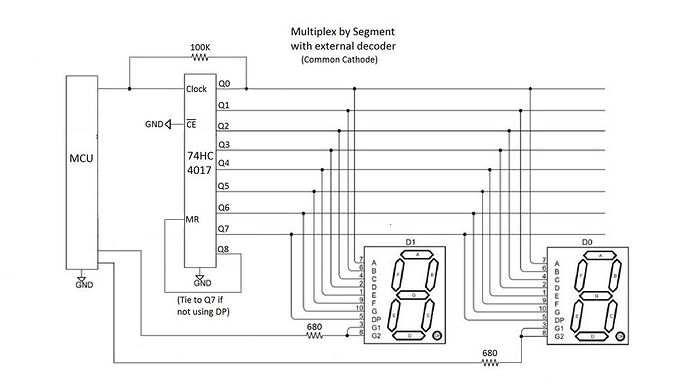Then the choice is MAX7219 as @johnwasser has suggested in Post-2. This is a SPI device and you require only 3-wires to drive an 8-digit display unit. The chip contains scanning circuit, power driver etc. See the diagram of Fig-1.
Figure-1:
Test Sketch (to show 4 5 6 7 on DP0, DP1, DP2, DP3 positions of display unit)
#include<SPI.h>
byte registerAddress[] = {0x0C, 0x09, 0x0A, 0x0B}; //control registers of MAX7219, see data sheets
byte registerData[] = {0x01, 0x00, 0x01, 0x07};
//normal modeo; no-decode;intensity;8-digit scan
byte dataArray[8]; //to hold cc-codes (no-decode format)
byte digitAddress[] = {0x01, 0x02, 0x03, 0x04, 0x05, 0x06, 0x07, 0x08};//DP0-DP7
byte lupTable[] = {0x7E, 0x30, 0x6D, 0x79, 0x33, 0x5B, 0x5F, 0x70,
0x7F, 0x7B, 0x77, 0x1F, 0x4E, 0x3D, 0x4F, 0x47
}; //0, 1, ...., E, F ; no-decode cc-code see data sheets
void setup()
{
pinMode(10, OUTPUT); //LOAD Pin of MAX7219
//-------------------
SPI.begin();
// bitSet(SPCR, 4); //UNO is Master SPI
// SPI.setBitOrder(MSBFIRST); //MSB_bit will be transferred first
SPI.setClockDivider(SPI_CLOCK_DIV128); //TX rate = 16MHz/128 = 125 kbit
// SPI.setDataMode(SPI_MODE1);//MOSI is sampled at the rising edge of CLK
//------------------------------------------------
digitalWrite(10, LOW); //Low at LOAD pin
//---- dataArray update-----------------------------
dataArray[0] = lupTable[4]; //no-decode cc-code of digit-4
dataArray[1] = lupTable[5]; //n0-decode cc-code of digit-5
dataArray[2] = lupTable[6]; //no-decode cc-code of digit-6
dataArray[3] = lupTable[7]; //no-decode cc-code of digit-7
//-------------------------------------------------
//---keep intializing the Mode of Operation------------
for (int i = 0; i < 4; i++)
{
SPI.transfer(registerAddress[i]);
SPI.transfer(registerData[i]);
digitalWrite(10, LOW);
digitalWrite(10, HIGH); //assert LH/LL on LOAD pin
digitalWrite(10, LOW);
}
//--keep transferring the result/data----------------------
for (int i = 0; i < 4; i++)
{
SPI.transfer(digitAddress[i]); //DPX position
SPI.transfer(dataArray[i]); //shows 4 5 6 7 on display
digitalWrite(10, LOW);
digitalWrite(10, HIGH); //assert LH/LL on LOAD pin
digitalWrite(10, LOW);
}
}
void loop()
{
}



